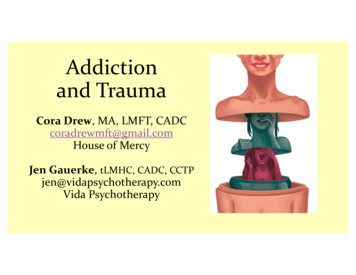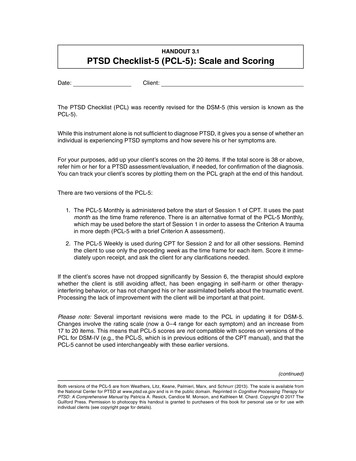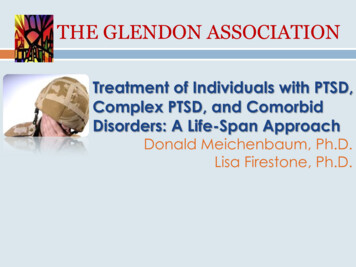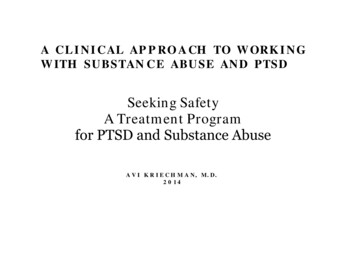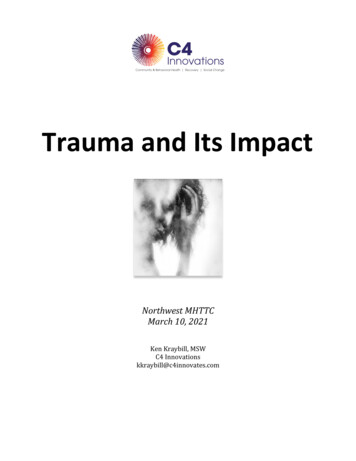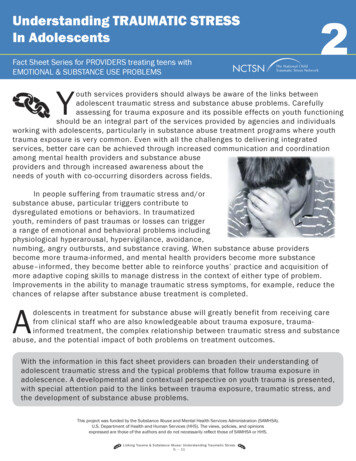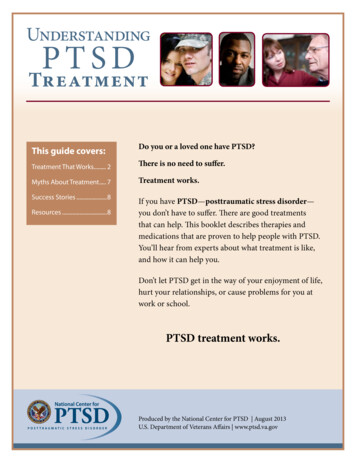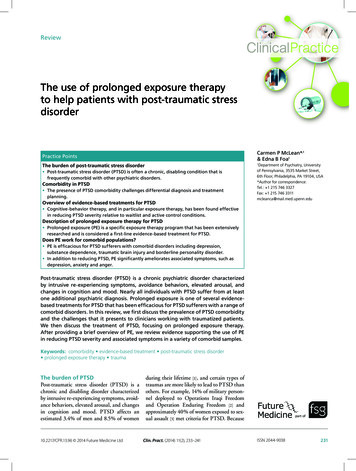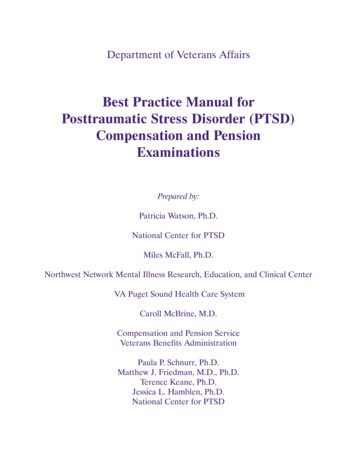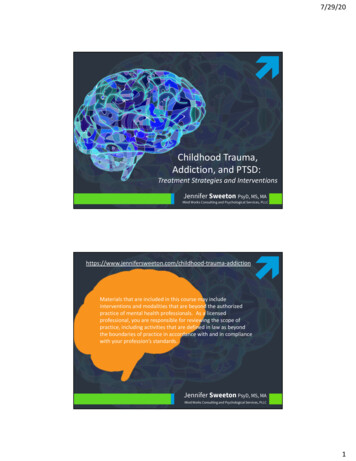
Transcription
7/29/20Childhood Trauma,Addiction, and PTSD:Treatment Strategies and InterventionsJennifer Sweeton PsyD, MS, MAMind Works Consulting and Psychological Services, ma-addictionMaterials that are included in this course may includeinterventions and modalities that are beyond the authorizedpractice of mental health professionals. As a licensedprofessional, you are responsible for reviewing the scope ofpractice, including activities that are defined in law as beyondthe boundaries of practice in accordance with and in compliancewith your profession’s standards.Jennifer Sweeton PsyD, MS, MAMind Works Consulting and Psychological Services, PLLC1
7/29/20Objectives Identify six key brain structures involved inaddiction and PTSD. Name two ways childhood trauma changes thebrain. State two ways therapy can change the brain forbetter mental health. Learn three brain-changing techniques that canreduce trauma and addiction symptoms.Jennifer Sweeton PsyD, MS, MA Mind Works Consulting and Psychological Services, PLLC Single Event vs. ComplexComplex trauma: Prolonged trauma or trauma thathappens at developmentally vulnerable times. According toCourtis and Ford, 2009:1. Repetitive or prolonged actions or inaction, that2. Involve direct harm and/or neglect by caregivers, that3. Occur during developmentally vulnerable times in thevictim's life, such as early childhood, and4. Have potential to severely compromise a child'sdevelopment.(Bessel van der Kolk (2005) refers to this as “developmentaltrauma.”)Jennifer Sweeton PsyD, MS, MA Mind Works Consulting and Psychological Services, PLLC2
7/29/20Complex Trauma Complex trauma repeated/ongoing threats of violation orviolence between a child and another person. Ex: bullying;emotional, physical or sexual abuse; child maltreatment orneglect; or witnessing domestic violence. Complex trauma thatdisrupts the development of secure attachment to a parent orprimary caregiver has the potential to have profounddevelopmental consequences for a child (De Bellis, 2001), and isthe most stressful trauma that a child can experience (Van Horn,2011). Complex trauma is associated with risk for developing PTSD(Alisic et al., 2014; McLaughlin et al., 2013), anxiety, and earlieronset and longer duration of depression (Cook et al., 2005). Alsoassociated with increased risk of autism, ADHD, conductdisorder, ODD, problem drug use, aggression, self-harm, andsuicide (Kilpatrick & Saunders, 1999; van der Kolk, 2003).Jennifer Sweeton PsyD, MS, MA Mind Works Consulting and Psychological Services, PLLC Adverse ChildhoodExperiences (ACEs) study 17,421 people examined over the lifespan Looked at adverse childhood experiences, including: Childhood abuse and neglect Domestic violence Substance abuse Parental discord Parent is in jail Crime Mental illness in the home, etc Jennifer Sweeton PsyD, MS, MA Mind Works Consulting and Psychological Services, PLLC3
7/29/20ACES FindingsACEs study found that the higher the score, especiallyif you have 4 (Developmental/Complex Trauma!) Attempted suicideChronic painChronic diseaseDepressionSmoking and lung diseaseCoronary heart diseaseDie 20 years soonerDrug addictionAlcohol misuseJennifer Sweeton PsyD, MS, MA Mind Works Consulting and Psychological Services, PLLCPart I: Neuroscience ofComplex Trauma and AddictionJennifer Sweeton PsyD, MS, MA Mind Works Consulting and Psychological Services, PLLC4
7/29/20Limbic SystemAmygdala“Fear brain” or “smoke alarm”Asks “Is this dangerous?”Involved in fear/threat detectionInvolved in implicit memoryComplex trauma overactivation,High baseline, reduced neuronalPruning Begins stress response throughactivation of the HPA axisJennifer Sweeton PsyD, MS, MA Mind Works Consulting and Psychological Services, PLLCLimbic SystemHippocampusInvolved in learning and memoryExplicit, declarative, autobiographicalmemoryImpaired functioning when understressComplex trauma underactive, atrophied. Never developedWell in the first place!Jennifer Sweeton PsyD, MS, MA Mind Works Consulting and Psychological Services, PLLC5
7/29/20Limbic SystemInsulaSite of proprioception andinteroceptionAllows us to be aware of internalexperiences and statesCritical for emotional awarenessComplex trauma under AND overactive, in different contexts.Sensations get paired with emotions/interpretations that make itSo that caregivers may be experienced as painful.Jennifer Sweeton PsyD, MS, MA Mind Works Consulting and Psychological Services, PLLCLimbic SystemNucleus Accumbens“Addiction Center”Involved in reward, laughter,pleasure , addictionImportant component of thereward pathways of the brainAddiction floods with dopamine when using/drinking, otherwiseturns off.Jennifer Sweeton PsyD, MS, MA Mind Works Consulting and Psychological Services, PLLC6
7/29/20Limbic SystemCingulate CortexConsidered a limbic ANDcortical structureInvolved in monitoring conflict,emotion regulation, painexpectancyContains the Anterior CingulateCortex, the “Emotion RegulationCenter”Complex trauma never fullyDevelopsJennifer Sweeton PsyD, MS, MA Mind Works Consulting and Psychological Services, PLLCCortex: Frontal LobePrefrontal Cortex:Rational thoughtComplex trauma lower activation and atrophyDue to too many glucocorticoid receptors.Goal-makingDecision-makingSense of othersPersonalityOFCPrimary Motor CortexMovementCingulate CortexEmotion regulationExpectation of painConflict monitoringJennifer Sweeton PsyD, MS, MA Mind Works Consulting and Psychological Services, PLLC7
7/29/20The Neuroscience ofTrauma and AddictionCingulate CortexPrefrontal CortexInsulaNucleus AccumbensHippocampusAmygdalaJennifer Sweeton PsyD, MS, MA Mind Works Consulting and Psychological Services, PLLCComplex Trauma in theBrain The prefrontal cortex is a region with protracted development and has high densityof glucocorticoid receptors (Gunnar & Quevedo, 2007), making it more vulnerableto trauma exposure. Structural changes associated with problems with memory,emotional regulation and self-regulatory capacities (Cook et al., 2005). Increased cortisol, impaired OFC (Kuhn & Schanberg, 1998). Underdeveloped LH and left hippocampus (Bremner et al., 1997). Accelerated loss of neurons/aging (Simantov, et. al., 1996) Inhibition of neurogenesis/regeneration of neurons (Gould, et. al., 1997) Abnormalities in developmentally appropriate pruning of neurons (Todd, 1992) Damage to the neuroreceptors that control the stress response, increase ofreceptors for cortisol, with the result that it is easier to be triggered. Prolonged exposure to certain types of glucocorticoids have also been associatedwith impaired neural plasticity (Glaser, 2000), which is the brain’s ability toreorganise itself in response to the environment. In children from six to 13 years of age, the corpus callosum develops significantly inrelation to language and memory (Pechtel & Pizzagalli, 2011), which may underlieobserved language impairments in some traumatised children (Zilberstein, 2014).Jennifer Sweeton PsyD, MS, MA Mind Works Consulting and Psychological Services, PLLC8
7/29/20Complex Trauma in theBrain Disrupted functioning of the sympathetic nervous system, and may have higherbaseline adrenaline and heart-rate levels (van der Kolk, 2003).The HPA axis helps activate or deactivate glucocorticoid hormones (e.g. cortisol) inresponse to stress. Impaired functioning of the HPA axis has been identified as akey pathway between trauma exposure and later developmental outcomes(Kearney et al., 2010). Frequent activation of the HPA axis may lead to overloadingthe body’s stress-response systems (Bradley & Corwyn, 2002) thereby damagingthe body’s central nervous system and organs.Irregular levels of glucocorticoid hormones in children with histories of trauma(Kearney et al., 2010), which has also been associated with reduced schoolengagement and academic achievement (Perkins & Graham-Bermann, 2012).Neuroimaging studies consistently find evidence of reduced hippocampal volumein adults who have experienced childhood trauma (Van Horn, 2011).Decreased cerebellum volume in children with histories of trauma exposure (Hart& Rubia, 2012). Reduction in cerebellum volume may be related to observeddisturbances in language, working memory and cognitive abilities such as planning(Pechtel & Pizzagalli, 2011; Teicher et al., 2003).Jennifer Sweeton PsyD, MS, MA Mind Works Consulting and Psychological Services, PLLCAttachment Attachment ruptures root of complex trauma Attachment ruptures affect theright hemisphere primarily. Right hemisphere that doesn’tdevelop on time leads to otherdeficits. Depending on age, critical period,different deficits may beexperienced.Jennifer Sweeton PsyD, MS, MA Mind Works Consulting and Psychological Services, PLLC9
7/29/20Outcomes of Secure AttachmentInclude Amygdalar pruningFull development of LHFull development of corpus callosumGood functioning of cerebellumNo interruptions of ACC developmentBasal ganglia develops on timeJennifer Sweeton PsyD, MS, MA Mind Works Consulting and Psychological Services, PLLCHealing AttachmentHow to promote and heal attachment?Help clients interact with other healthy brains:“All this talk therapy is just an excuse to hangout long enough for the relationship to do thehealing.” - SEPI conference on Attachment and Relationships,2002.Jennifer Sweeton PsyD, MS, MA Mind Works Consulting and Psychological Services, PLLC10
7/29/20Part II: Ways to Change theBrainJennifer Sweeton PsyD, MS, MA Mind Works Consulting and Psychological Services, PLLCWays to Change the Brain:Three Options123Bottom-up interventions:Working with the body/going through thebody to change the brainTop-down processing:Working with the mind/going through themind to change the brainHorizontal processing:Working across hemispheres or acrosssensory modalitiesJennifer Sweeton PsyD, MS, MA Mind Works Consulting and Psychological Services, PLLC11
7/29/20Bottom-up InterventionsGoing through the body/senses to change the brain(especially the lower parts of the brain)Jennifer Sweeton PsyD, MS, MA Mind Works Consulting and Psychological Services, PLLCBottom-up InterventionsSensory awareness orexposure techniquesDiaphragmatic breathingHavening techniquesBody scanSensorimotor techniquesProgressive muscle relaxationYogaAutogenic training (bothbottom-up and top-down)QigongExerciseJennifer Sweeton PsyD, MS, MA Mind Works Consulting and Psychological Services, PLLC12
7/29/20Top-down InterventionsUsing the mind (thoughts) to change the brain(usually the upper parts of the brain)Jennifer Sweeton PsyD, MS, MA Mind Works Consulting and Psychological Services, PLLCTop-down InterventionsCognitive restructuring/reappraisalAutogenic training (bothbottom-up and top-down)Acceptance and CommitmentTherapy cognitive exercisesEmpty chair techniqueTranscendental meditationAssertiveness training,communication techniquesFocus meditationsTalk therapyJennifer Sweeton PsyD, MS, MA Mind Works Consulting and Psychological Services, PLLC13
7/29/20Trauma Treatment Roadmap1. Build the alliance (bottom-up, reduces cortisol)2. Safely enter the body (increase insula activation)3. Practice bottom-up techniques (decrease amygdala activation,increase hippocampal activation/volume)4. Incorporate top-down techniques (strengthen PFC andcingulate)5. Consider trauma-focused/exposure/memoryreconsolidation techniques (imaginal exposure,neuromodulation, etc.; strengthens hippocampus/changes howmemories are stored)6. Integrate behavioral techniques (help amygdala self-regulate;bottom-up and top-down)Jennifer Sweeton PsyD, MS, MA Mind Works Consulting and Psychological Services, PLLCTrauma Treatment RoadmapIn complex trauma, a LOT of the work you do will be bottom—up and experiential, and will aim to: Balance/integrate functioning of both hemispheres of thebrain, Regulate the stress response system (brain AND bodywork), and Integrate “protection” with “connection”Cognitive work is great too, but be careful about entering thistoo early, or focusing on this as opposed to more somatic andattachment-based work. Logic won’t change these clients’experience; they need a reparative experience where theysafely connect with themselves and others.Jennifer Sweeton PsyD, MS, MA Mind Works Consulting and Psychological Services, PLLC14
7/29/20Treating AddictionAddiction doc says: It’s not the drugs. It’s the ACEs adversechildhood experiences.Addiction shouldn’t be called “addiction”. It should be called “ritualizedcompulsive comfort-seeking.”Ritualized compulsive comfort-seeking (what traditionalists call addiction) isa normal response to the adversity experienced in childhood, just likebleeding is a normal response to being stabbed.The solution to changing the illegal or unhealthy ritualized compulsivecomfort-seeking behavior of opioid addiction is to address a person’s adversechildhood experiences (ACEs) individually and in group therapy; treat peoplewith respect; provide medication assistance in the form of buprenorphine, anopioid used to treat opioid addiction; and help them find a ritualizedcompulsive comfort-seeking behavior that won’t kill them or put them in jail. Dr. Daniel Sumrok, director of the Center for Addiction Sciences at theUniversity of Tennessee Health Science Center’s College of ople-can-recover/Jennifer Sweeton PsyD, MS, MA Mind Works Consulting and Psychological Services, PLLCBuild the AllianceJennifer Sweeton PsyD, MS, MA Mind Works Consulting and Psychological Services, PLLC15
7/29/20Trauma Treatment Roadmap1. Build the alliance (bottom-up, reduces cortisol)2. Safely enter the body (increase insula activation)3. Practice bottom-up techniques (decrease amygdala activation,increase hippocampal activation/volume)4. Incorporate top-down techniques (strengthen PFC andcingulate)5. Consider trauma-focused/exposure/memoryreconsolidation techniques (imaginal exposure,neuromodulation, etc.; strengthens hippocampus/changes howmemories are stored)6. Integrate behavioral techniques (help amygdala self-regulate;bottom-up and top-down)Jennifer Sweeton PsyD, MS, MA Mind Works Consulting and Psychological Services, PLLCNeuroscience of theTherapeutic Alliance Therapeutic alliance Bottom-up approach to therapy The therapeutic alliance accounts for between 15-50%of the outcome variance (depending on which studiesyou believe). Various bodies of research indicate that brains caninteract with and influence other brains – Brain waves align when people make eye contact and“attune”– Mothers can soothe infants and reduce their cortisol byfocusing on them using their PFC (through eye contact andtouch)Jennifer Sweeton PsyD, MS, MA Mind Works Consulting and Psychological Services, PLLC16
7/29/20Implications of Mirror Neurons Mirror neurons are the neural mechanism of thetherapeutic alliance. They allow clients to have a different, (hopefully)reparative experience in therapy. The mirror neuron system is the foundationalbuilding block for empathy, led to new theory ofempathy. Clients can, through this alliance, re-learn andheal attachment.Jennifer Sweeton PsyD, MS, MA Mind Works Consulting and Psychological Services, PLLCSocial Medicine is Real! Connection with others – “social medicine”: Reduces cardiovascular reactivity (Lepore, et al, 1993) Reduces blood pressure (Spitzer, et al, 1992) Reduces vulnerability to catching a cold (Cohen, et al, 2003)Reduces anxiety (Cohen, 2004)Slows cognitive decline (Bassuk, et al 1999)Improves sleep (Cohen, 2004)Improves depression (Russell & Cutrona, 1991)Reduces cortisol levels (Kiecolt-Glaser, et al, 1984)Jennifer Sweeton PsyD, MS, MA Mind Works Consulting and Psychological Services, PLLC17
7/29/20Build Connection“The opposite of addiction isn’t sobriety, it’s connection.” Johann Harihttps://www.ted.com/talks/johann hari everything you think you know about addiction is wrong?language ed relational mindfulness (Ogden & Fisher)Intentional attentionMotivational Interviewing (also could go in “top down”category)Jennifer Sweeton PsyD, MS, MA Mind Works Consulting and Psychological Services, PLLCMirroring ExerciseJennifer Sweeton PsyD, MS, MA Mind Works Consulting and Psychological Services, PLLC18
7/29/20Following ExerciseJennifer Sweeton PsyD, MS, MA Mind Works Consulting and Psychological Services, PLLCHow To AttuneCo-regulation:– Watch for breathing changes– Relax muscles in neck/shoulders/back– Produce in yourself the sensations/physiology you want theclient to experience– Notice somatic countertransference, which may indicatesomething about what the client is feelingJennifer Sweeton PsyD, MS, MA Mind Works Consulting and Psychological Services, PLLC19
7/29/20How To AttuneEmbedded relational mindfulness (Ogden & Fisher): Part ofSensorimotor Psychotherapy where you focus on internalprocesses client is experiencing in the here-and-now, and putwords to the somatic experiences. It’s mindfulness occurringbetween the client and therapist, in relationship with oneanother. “I noticed that when you mentioned your father, yourshoulders tensed ” ”What’s happening right now in your hands?” “Where is the anger in your body?” Consider a body scan, developing a physical profile ofdifferent emotions or beliefs.Putting language to experience integrates the hemispheres!!Jennifer Sweeton PsyD, MS, MA Mind Works Consulting and Psychological Services, PLLCHow to Attune: Intentional Attention“As you talk about that, look over to your right ”(distraction/disruption)“Remembering that event, notice that sensation in yourchest ” (exposure)“What’s one area of the body that does NOT feel anydistress right now? Feel into that ” (resourcing).Therapist can also strategically direct the client’s attentionto different somatic experiences or eye placements, for thepurpose of exposure, distraction, or resourcing (Ogden &Fisher).Jennifer Sweeton PsyD, MS, MA Mind Works Consulting and Psychological Services, PLLC20
7/29/20How To AttuneMotivational Interviewing (Miller and ef sr 1 2?dchild 1&keywords motivational interviewing&qid 1592791100&s books&sr 1-2 Helps clients move through the stages of change. Reduces stigma of addiction, normalizes desire to use, cravings Nonconfrontational and collaborative, meant to increasemotivation for change Person-centered, strengthens the therapeutic alliance Follows Self-Determination Theory, which says people changewhen:– They have autonomy in decision-making– They have a sense of mastery and competence– They are connected to others and feel supported by key peopleJennifer Sweeton PsyD, MS, MA Mind Works Consulting and Psychological Services, PLLCHow To AttuneMotivational Interviewing OARS:––––Open-ended questionsAffirming*** (Acknowledge the upsides of using/drinking)Reflective listeningSummarizing Goal is to elicit change talk through helping clients identifyambivalence Elicit change talk:– What do you value?– What would you like in your life?– How does your behavior support your goals, or get in the way ofthem?– What gets in the way of you accomplishing this goal?Jennifer Sweeton PsyD, MS, MA Mind Works Consulting and Psychological Services, PLLC21
7/29/20Safely Work with the BodyJennifer Sweeton PsyD, MS, MA Mind Works Consulting and Psychological Services, PLLCTrauma Treatment Roadmap1. Build the alliance (bottom-up, reduces cortisol)2. Safely enter the body (increase insula activation)3. Practice bottom-up techniques (decrease amygdala activation,activate hippocampus)4. Incorporate top-down techniques (strengthen PFC andcingulate)5. Consider trauma-focused/exposure/memoryreconsolidation techniques (imaginal exposure,neuromodulation, etc.; strengthens hippocampus/changes howmemories are stored)6. Integrate behavioral techniques (help amygdala self-regulate;bottom-up and top-down)Jennifer Sweeton PsyD, MS, MA Mind Works Consulting and Psychological Services, PLLC22
7/29/20Safely Enter the BodySelf-awareness is needed for self-regulation. When addictionis present, experiencing the self is unbearable.Grounding/Sensory AwarenessMindfulnessLocating safety/strength/comfort in the body.Heartbeat BalanceJennifer Sweeton PsyD, MS, MA Mind Works Consulting and Psychological Services, PLLCBottom-Up TechniquesJennifer Sweeton PsyD, MS, MA Mind Works Consulting and Psychological Services, PLLC23
7/29/20Trauma Treatment Roadmap1. Build the alliance (bottom-up, reduces cortisol)2. Safely enter the body (increase insula activation)3. Practice bottom-up techniques (decrease amygdala activation,increase hippocampal activation)4. Incorporate top-down techniques (strengthen PFC andcingulate)5. Consider trauma-focused/exposure/memoryreconsolidation techniques (imaginal exposure,neuromodulation, etc.; strengthens hippocampus/changes howmemories are stored)6. Integrate behavioral techniques (help amygdala self-regulate;bottom-up and top-down)Jennifer Sweeton PsyD, MS, MA Mind Works Consulting and Psychological Services, PLLCBottom-Up Techniques: Body-Based Tools**Increases insula, decreases amygdalaactivation!** Tense & Release Conditioned Relaxation Tense/limp spaghetti Color-Your-LifeJennifer Sweeton PsyD, MS, MA Mind Works Consulting and Psychological Services, PLLC24
7/29/20Progressive Muscle Relaxation10 - Face9 - Jaw8 - Shoulders7 – Upper back6 - Arms5 - Hands4 - Abdomen3- Upper legs2-Lower legs1 - FeetProgressive MuscleRelaxation For ChildrenThis exercise will help us learn the difference between being tense and being relaxed and teach aneasy way to relax.Now imagine that you are piece of cooked spaghetti. Tighten both your fists and arms, squeezeyour legs and stomach and make your whole body as stiff as possible, so that you can’t bend.Keep your whole body tense until you count to five.Now relax. Pretend that you are now a piece of cooked spaghetti. Let your whole body becomeloose and floppy. Let go of all of the tension in your body. Relax your shoulders and stomach, takea deep breath, and let your body be as loose and floppy as cooked spaghetti.Which feels better, being cooked or uncooked spaghetti?Now become raw spaghetti again. Squeeze all the muscles in your body until you are as stiff asraw spaghetti. Even make your face tense – squeeze all the muscles in your mouth and forehead.Squeeze your shoulders up to your ears. Make fists with your hands. Squeeze your eyes shut andpush your feet into the floor. Hold your body stiff like raw spaghetti until the count of five. Nowrelax your whole body. Go floppy like raw spaghetti. Relax your face, your shoulders, yourstomach, your arms and your legs.Now which felt better, being cooked or uncooked dfJennifer Sweeton PsyD, MS, MA Mind Works Consulting and Psychological Services, PLLC25
7/29/20Color Your Life Match feelings to colors When you think of xxx, what feeling goes with it?Blue - SadGray - LonelyRed – AngryGreen - JealousPurple – RageYellow – HappyBrown – BoredBlack – Very sad “Color the paper with any color of a feeling you’ve ever felt.” “Color where you feel different feelings ” Then can imagine different colors in different areas: “Imagine yellow inyour tummy ” https://www.youtube.com/watch?v PAIwlAMieV8Jennifer Sweeton PsyD, MS, MA Mind Works Consulting and Psychological Services, PLLCStrengthen Hippocampus! BDNF brain derived neurotrophic factor– Consolidates connections between neurons– Promotes growth of myelin to make neurons fire more efficiently– Acts on stem cells in the hippocampus and PFC to grow intoBRAND NEW NEURONS! Increase your neurogenesis by – Exercise / novel movement / dance– Meditation– Incorporating Omega-3s into your diet Decrease your neurogenesis by – Aging (sorry!)– Experiencing chronic stress– Marijuana use / too much alcohol useJennifer Sweeton PsyD, MS, MA Mind Works Consulting and Psychological Services, PLLC26
7/29/20Top-Down TechniquesJennifer Sweeton PsyD, MS, MA Mind Works Consulting and Psychological Services, PLLCTrauma Treatment Roadmap1. Build the alliance (bottom-up, reduces cortisol)2. Safely enter the body (increase insula activation)3. Practice bottom-up techniques (decrease amygdala activation)4. Incorporate top-down techniques (strengthen PFC andcingulate)5. Consider trauma-focused/exposure/memoryreconsolidation techniques (imaginal exposure,neuromodulation, etc.; strengthens hippocampus/changes howmemories are stored)6. Integrate behavioral techniques (help amygdala self-regulate;bottom-up and top-down)Jennifer Sweeton PsyD, MS, MA Mind Works Consulting and Psychological Services, PLLC27
7/29/20Mindful Craving Check-InHALT and check in!HHungerAAngerLLonelinessTTirednessMindful Check-In recommendedto assess for these and engage in amindfulness practice.Jennifer Sweeton PsyD, MS, MA Mind Works Consulting and Psychological Services, PLLCConcentration MeditationKnown as transcendental meditationConcentration-based practice where participants focus on a sensation,object, sound, or other single stimulus (Delmonte, 1985; Smith, 1975)Mantras or affirmations commonly used in this practiceTrains individuals to prevent distracting thoughts by restricting theirattention to one stimulus. This help participants reduce anxietyJennifer Sweeton PsyD, MS, MA Mind Works Consulting and Psychological Services, PLLC28
7/29/20Evidence-based treatments Developmental Trauma: Attachment-based work, DBT, ACT,CBT, TF-CBT, Trauma-focused interventions PTSD: Prolonged Exposure, Cognitive Processing Therapy,EMDR, Stress Inoculation Therapy, Trauma Focused CognitiveBehavioral Therapy Addiction: Seeking Safety, Integrated Dual DisorderTreatment, behavioral/CBT, DBT, Motivational Interviewing,pharmacological therapies, Family TherapyJennifer Sweeton PsyD, MS, MA Mind Works Consulting and Psychological Services, PLLCBehavioral TechniquesJennifer Sweeton PsyD, MS, MA Mind Works Consulting and Psychological Services, PLLC29
7/29/20Behavioral Ideas“Help them find a ritualized compulsive comfort-seeking behaviorthat won’t kill them or put them in jail.” Dr. Daniel Sumrok Using substances is self-neglect – set aside protected time for self-carebehaviors Engage in drug-free friendships Get a change in scenery Engage with pets/animals Participate in recreational/pleasurable activities Connect with spiritual practices/pray Exercise and the incorporation of other movements Adopt a repetitive hobby (knitting, swimming, running, etc.)See examples Seeking Safety-type exercises in the materials!It may take several months (up to 2 years) to FEEL the benefit ofthese behaviors due to the nucleus accumbens needing to learnhow to activate again in response to things other thandrugs/alcohol!Jennifer Sweeton PsyD, MS, MA Mind Works Consulting and Psychological Services, ma-addictionThank .comwww.facebook.com/drjsweetonJennifer Sweeton PsyD, MS, MAMind Works Consulting and Psychological Services, PLLC30
7/29/20Limitations of NeuroscienceResearch fMRI imaging measures blood flow, and cannot directly measure neuronalactivity. Neuronal signaling occurs approximately 1,000 faster than bloodflow, meaning that what we observe in fMRI research is much slower thanactual neuronal activity, and may not correspond directly to this activity. Due to the high cost of conducting neuroscience research, many studieshave a relatively small sample size compared to other types ofpsychological research. This can compromise validity. fMRI research identifies brain activations through the measurement ofblood flow. However, some research has shown that it is possible formental tasks to produce less activation in specific brain areas comparedto brain activity at rest. Thus, looking solely at brain activations, notdeactivations, may produce an incomplete picture of brain functioning. Some neuroscience research has been conducted on animals, and may notbe directly applicable to humans.Jennifer Sweeton PsyD, MS, MA Mind Works Consulting and Psychological Services, PLLCReferencesAhmed-Leitao, F., Spies, G., van den Heuvel, L., & Seedat, S. (2016). Hippocampal and amygdala volumes in adults with posttraumatic stressdisorder secondary to childhood abuse or maltreatment: a systematic review. Psychiatry Research: Neuroimaging, 256, 33-43.Ainsworth, M.; Blehar, M.; Waters, E.; and Wall, S. (1978). Patterns of attachment. Hillsdale, NJ: Erlbaum.Beach, P. S., & McCormick, D. P. (1997). Maintaining health in the infant and preschool child. In C. W. Daeschner, & C. J. Richardson (Eds.),Pediatrics: An approach to independent learning (pp. 87-103). Baltimore: Johns Hopkins Press.Baylin, J (2013) Behavioral Epigenetics and Attachment. The Neuropsychotherapist.Crusto, C. A., Finley, M., Kaufman, J., Griffin, A., Berson, I., & Garcia-Casellas, M., et al. (2009, March). Characteristics of children presenting toearly childhood mental health systems of care. Paper presented at the annual research conference of the Research & Training Center (RTC)for Children's Mental Health, Tampa, FL. Retrieved from /pdf/22/Session%2011/Whitson.pdfDicker, S., Gordon, E., & Knitzer, J. (2001). Improving the odds for the healthy development of young children in foster care. New York:Columbia University, National Center for Children in Poverty. Retrieved from http://www.ithaca.edu/mbentley/pdf/dicker.pdf }Felitti, et al (1998). Relationship of Childhood Abuse and Household Dysfunction to Many of the Leading Causes of Death in Adults. Am J PrevMed14(4).Gr
7/29/20 2 Objectives Jennifer SweetonPsyD, MS, MA Mind Works Consulting and Psychological Services, PLLC Identify six key brain structures involved in addiction and PTSD. Name two ways childhood trauma changes the brain. State two ways therapy can change the brain for better mental health. Learn three brain-changing techniques that can reduce trauma and addiction symptoms.

